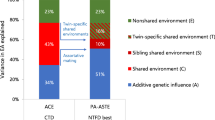Abstract
Scores of occupational status, educational attainment, and IQ were obtained for 507 monozygotic and 575 dizygotic male twin pairs born 1931–1935 and 1944–1960. A multivariate genetic analysis with statistics from different cohorts showed heterogeneity between cohorts, and analyses were performed in four separate cohorts. The only set of results which departed clearly from the rest was found for the group born 1931–1935, where the ratio of environmental to genetic effects exceeded those of the other groups. Typical heritability values in the three youngest groups (weighted means) were .43, .51, and .66 for occupation, education, and IQ, respectively. The values in the oldest group were .16, .10, and .37, but this sample is small and the estimates are unstable. Genetic variance influencing educational attainment also contributed approximately onefourth of the genetic variance for occupational status and nearly half the genetic variance for IQ. The values for the between-families variances (reflecting family environment and assortative mating) varied from 2 to 35% in the three youngest groups but were higher for education (62%) and IQ (45%) in the oldest groups. All the between-families variance was common to all three variables. For educational attainment and IQ, the bulk of this between-families variance is probably genetic variance due to assortative mating. The common-factor environmental within-family variances were generally small, and the specific estimates seemed to contain mainly measurement error.
Similar content being viewed by others
References
Bouchard, T., and McGue, M. (1981). Family studies of intelligence. A review.Science 212:1055–1059.
Eaves, L. J., Last, K. A., Young, P. A., and Martin, N. G. (1978). Model-fitting approaches to the analysis of human behaviour.Heredity 41:249–320.
Eaves, L. J., Heath, A. C., and Martin, N. G. (1984). A note on the generalized effects of assortative mating.Behav. Genet. 14:371–376.
Engvik, H., and Tambs, K. (1985).WAIS. Supplementary Manual, ISV-Test, Oslo, Norway.
Faglig Memorandum nr. 12. B Utskrivningsprøvene, (1956). Note, Department of Psychology, Norwegian Army, Oslo.
Fulker, D. W. (1978). Multivariate extensions of a biometrical model of twin data. In Nance, W. E. (ed.),Progress in Clinical and Biological Research, Vol. 24a Alan R. Liss, New York.
Grøndal, K. (1986).Metodiske aspekter og begrensninger ved arvelighetsanalyser belyst vel IQ-data fra eneggede tvillinger og deres familier, Dissertation, University of Oslo, Oslo, Norway.
Heath, A. C., Berg, K., Eaves, L. J., Solaas, M. H., Corey, L. A., Sundet, J., Magnus, P., and Nance, W. E. (1985a). Educational policy and the heritability of educational attainment.Nature 314:734–736.
Heath, A. C., Berg, K., Eaves, L. J., Solaas, M. H., Sundet, J. M., Nance, W. E., Corey, L. A., and Magnus P. (1985b). No decline in assortative mating for educational level.Behav. Genet. 15:349–369.
Jöreskog, K. G., and Sörbom, D. (1978).LISREL: Analysis of Linear Structural Relationships by the Method of Maximum Likelihood, Version IV, International Educational Services, Chicago.
Lundgren, E. A., and Skjenstad, H. (1953).Figurregler, Test manual, Department of Psychology, Norwegian Army, Oslo, Norway.
Lykken, T. D., McGue, M., and Tellegen, A. (1987). Recruitment bias in twin research: The rule of two-thirds reconsidered.Behav. Genet. 17:343–362.
Magnus, P., Berg, K., and Nance, W. E. (1983). Predicting zygosity in Norwegian twin pairs born 1915–1960.Clin. Genet. 24:103–112.
Martin, N. G. (1978). Genetics of sexual and social attitudes in twins. InTwin Research: Psychology and Methodology, Alan R. Liss, New York.
Martin, N. G., and Eaves, L. J. (1977). The genetical analysis of covariance structure.Heredity 53(1):79–95.
Martin, N. G., and Wilson, S. R. (1982). Bias in the estimation of heritability from truncated samples of twins.Behav. Genet. 12:467–472.
Martin, N. G., Jardine, R., and Eaves, L. J. (1984). Is there only one set of genes for different abilities? A reanalysis of the National Merit Scholarship Qualifying Test (NMSQT) data.Behav. Genet. 14:355–370.
Nordisk Yrkesklassifisering (1978). Arbetsmarknadsstyrelsen, Helsingborg, Sweden.
Rideng (1980).SSB's nye kommunetypologi, Central Bureau of Statistics, Oslo, Norway.
Sundet, J. M., Tambs, K., Magnus, P., and Berg, K. (1988). On the question of secular trends in the heritability of intelligence test scores. A study of Norwegian twinsIntelligence 12:47–59.
Tambs, K., and Sundet, J. M. (1985). Heredity and environmental influence in educational attainment. The effect of genes and environmental factors on differences in education attainment, intelligence, professional status, and need achievement estimated in a twin study.Tidsskr. Samfunnsforsk. 26:437–456.
Tambs, K., Sundet, J. M., Magnus, P., and Berg, K. (1989). No recruitment bias for questionnaire data related to IQ in classical twin studies.Person. individ. Diff. 10:269–271.
Tambs, K., Sundet, J. M., and Magnus, P. (1984). Heritability analysis of the WAIS subtests. A study of twins.Intelligence 8:283–293.
Tambs, K., Sundet, J. M., and Magnus, P. (1986). Genetic and environmental contributions to the covariation between the Wechsler Adult Intelligence Scale (WAIS) Subtest: A study of twins.Behav. Genet. 16:475–491.
Taubman, P. (ed.) (1977).Kinometrics: The Determinants of Socioeconomic Success Within and Between Families, North-Holland, Amsterdam.
Vogler, G. P., and Fulker, D. W. (1983). Familial resemblance for educational attainment.Behav. Genet. 13:341–354.
Author information
Authors and Affiliations
Rights and permissions
About this article
Cite this article
Tambs, K., Sundet, J.M., Magnus, P. et al. Genetic and environmental contributions to the covariance between occupational status, educational attainment, and IQ: A study of twins. Behav Genet 19, 209–222 (1989). https://doi.org/10.1007/BF01065905
Received:
Accepted:
Issue Date:
DOI: https://doi.org/10.1007/BF01065905




